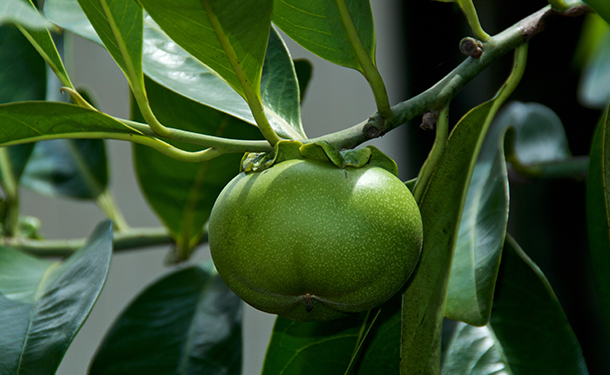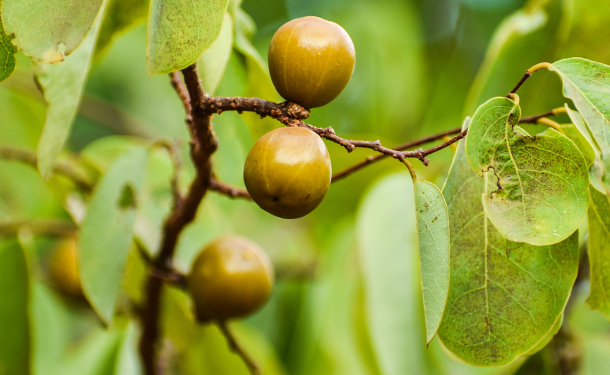Avoid severe blistering, respiratory complications, and potential death caused by contact with a manchineel tree. Knowing how this tree species can adversely affect your health will help you remain vigilant in avoiding its bark, sap, foliage, and fruit.

thetreecareguide.com gathered essential information and warnings about the manchineel tree and what it can do to you.
Manchineel Tree Information
The manchineel tree (Hippomane mancinella), also referred to as “poison guava” or “beach apple,” is a species of flowering plant from the spurge family. Its native range reaches from tropical southern North America to northern South America and is typically found on sandy beaches.
Warning: All parts of the manchineel tree are extremely poisonous, and interaction with or ingestion of any part of this tree may be lethal.
Hippomane Mancinella Toxicity
All parts of the manchineel tree, including its fruit, is poisonous, and according to The Guinness Book of World Records, it was deemed the most dangerous tree in the world in 2011. This tree’s toxicity is well known and documented. Centuries ago, Christopher Columbus referred to the tree’s fruit as “Manzanilla de la Muerte,” or the little apple of death.
Manchineel Tree Identification
You can identify this poisonous evergreen tree by its grayish or brown, scaly or fissured bark, small greenish-yellow blooms, and shiny (almost waxy) green leaves. The Manchineel tree’s glossy leaves are alternately arranged on the stems and have a rounded base with pointed tips, and have either smooth or slightly toothed edges that may be slightly bent upward.
The leaves are shiny on the upper surface and dull underneath. Leaves grow 2 to 4 inches long and 1 to 3 inches wide. The leaves have a single conspicuous central vein which (when damaged) bleeds a toxic milky sap in young plants.
The tree’s numerous small fruits are primarily green or greenish-yellow when ripe, often highlighted with red, and similar in appearance to an apple. This appearance and toxicity have garnered the little fruit with the name “death apple.”
What Does The Manchineel Tree Do to You?
Poisoning symptoms can include nausea and diarrhea followed by shock and severe muscle weakness. If the machineel fruit is eaten, the person may experience burning and swelling of the mouth and throat, nausea, diarrhea, and severe stomach pain. This person will be unable to swallow, talk, or breathe, potentially leading to death.
The fruit has been described as having a peppery taste that leads to a tearing, burning sensation followed by a tightening of the throat until swallowing and breathing become challenging.

This species’ milky white sap contains phorbol, along with other skin irritants, producing intense allergic contact dermatitis, including blistering and swelling. This contact may also lead to severe conjunctivitis with blindness for up to 72 hours.
Note: Merely standing beneath the tree during rain will cause severe skin blistering from contact with this liquid. Even a tiny drop of rain with the milky substance will cause your skin to blister.
How To Treat Manchineel Poisoning
Manchineel dermatitis and ophthalmitis treatment should include immediate and vigorous cleansing to remove the toxin-filled latex and follow-up symptomatic measures, including cool compresses and anti‐irritants. Typically, corticosteroids have been suggested/prescribed as treatment in severe cases (especially involving the eyes).
Get help from Poison Control immediately if you suspect beach apple ingestion or manchineel poisoning. Free, expert help is available 24/7 from Poison Control Centers at:
(800) 222-1222 or triage.webpoisoncontrol.org
What Is the Manchineel Tree Used for
Centuries ago, manchineel’s highly toxic sap was used by Caribbean Indians as arrow poison. Despite this tree’s dangerous nature, people have used manchineel wood to make furniture for generations. This process involves carefully cutting the wood and sun drying it to neutralize its poisonous sap.
Note: Native people used manchineel as medicine, including the gum for edema and its dried fruits as a potent diuretic.
What Is the Ecological Value of Manchineel Trees
The manchineel tree provides food, shelter, and habitat for some species that have developed an immunity to its toxicity. It also combats natural beach erosion and can serve as an efficient windbreak during severe tropical storms.
The Poisonous Manchineel Tree
In this article, you discovered essential species information, advisories, and warnings about the poisonous manchineel tree and how to seek help when ingested.
Knowing how to identify and avoid the manchineel tree will help you avoid severe skin rash, painful blisters, and other unpleasant side effects.
Ignoring the toxicity and inherent danger of the manchineel tree can cause nausea and diarrhea followed by shock and severe muscle weakness. Once ingested, this tree’s fruit can kill you without seeking immediate medical attention.
Sources:
npr.org/2022/08/25/1119333236/worlds-most-dangerous-tree-manchineel-florida
nps.gov/viis/planyourvisit/upload/TrifoldHazardPlandstoAvoid.pdf
ncbi.nlm.nih.gov/pmc/articles/PMC1127797/
edis.ifas.ufl.edu/publication/FR370